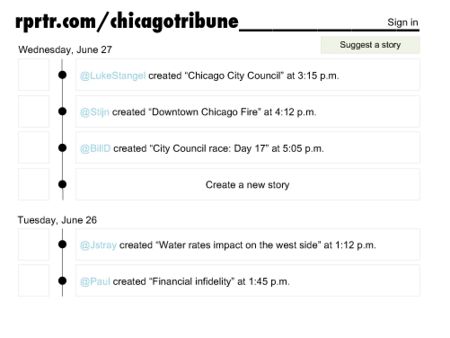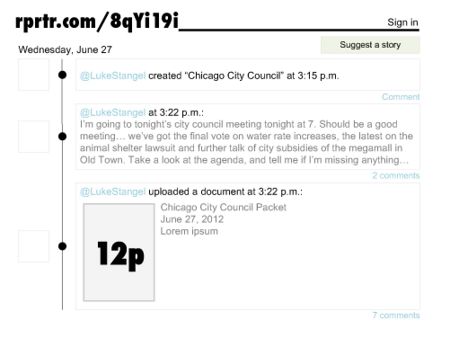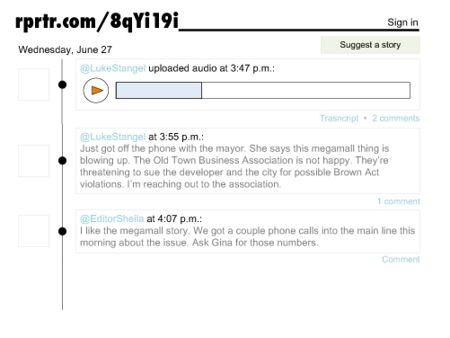Difference between revisions of "Rji-pivot-project-reporters-notebook"
| Line 13: | Line 13: | ||
If you were to chart out the lifecycle of the average article, it would look something like this: | If you were to chart out the lifecycle of the average article, it would look something like this: | ||
<br><br> | <br><br> | ||
| − | [[Image:Rji-pivot-reporters1.jpg| | + | [[Image:Rji-pivot-reporters1.jpg|450px|thumb|right| VIEW PRINTABLE PDF: http://newshare.com/pivot/reporters-notebook.pdf]] |
| − | [[Image:Rji-pivot-reporters2.jpg| | + | [[Image:Rji-pivot-reporters2.jpg|450px|thumb|right| VIEW PRINTABLE PDF: http://newshare.com/pivot/reporters-notebook.pdf]] |
| − | [[Image:Rji-pivot-reporters3.jpg| | + | [[Image:Rji-pivot-reporters3.jpg|450px|thumb|right| VIEW PRINTABLE PDF: http://newshare.com/pivot/reporters-notebook.pdf]] |
|---->1---->2---->3---->4---->5---->6-----| | |---->1---->2---->3---->4---->5---->6-----| | ||
Revision as of 18:22, 4 July 2012

|
1. Reporters Notebook
- A method for the public to engage with the reporting process in real time from the moment a story idea is conceived. Reporter's Notebook is Yammer for newsrooms. Reporters create a public page showing each step in the editorial production process, with text, photos, video, documents, links, and transcribed audio. Editors can access the newsroom's live workflow, and comment on the process during the day. The public follows along, commenting on specific content pieces. The resulting goal is total transparency. Champion: Luke Stangel
At a high level, what we're trying to fix here is the public's lack of trust in the journalism process and the reporter's lack of transparency to the public.
If you were to chart out the lifecycle of the average article, it would look something like this:



|---->1---->2---->3---->4---->5---->6-----|
- The reporter decides to write an article about a specific subject.
- The reporter gathers information about the subject alone.
- The reporter writes the article and submits it for editing.
- The editor sees the article for the first time, makes edits, sends it off for publication.
- Article is published. Public sees the article for the first time.
- Public discusses the article, comments on the article and shares the article.
The three interested parties (reporter, editor and the public) have very little visibility with one another. During steps 1-3, the reporter essentially works
alone, gathering and parsing information alone, writing alone. During step 4, the editor sees the article for the first time, and there's (often) very little
time to make significant, structural changes to the work. During steps 5 and 6, the public talks about the article and shares the article, but the reporter and
the editor largely ignore the feedback loop.
By getting the editor and the public involved from step 1, we take a big step toward greater transparency, and collaborative journalism.
Is this too radical for 'journalists'?
Could this product be too radical for journalists? The average reporter is a lone wolf and proud of it. If they use digital tools (like Twitter), they usually do so badly. Journalists are crunched for time, and don't want to adopt something they feel is unnecessary. They don't really want the public and their editors peering over their shoulders watching the work come together. Reporter's Notebook represents a nice sentiment, but it will probably fail completely in the market. Plus, there's no sustainable business model.
That's said, because I believe a product like Reporter's Notebook could be incredibly valuable for journalism. The act of gathering information and crafting it
into an article is a fascinating process, and opening that up to the public would probably generate a lot of interest in that article. Reporters are often seen
as elitist, or inaccessible, so when they make mistakes in their coverage, the public assumes they're either incompetent or biased. By embracing total
transparency, we could build a lot of trust among our readers, viewers and listeners.
What's needed to build Reporter's Notebook
To build something like this, we'd need:
- A developer and a designer.
- Funding to pay for development, design, servers and business development. (I'd estimate $200,000).
- News organizations who would be willing to embrace a radical product like this, getting buy-in from the entire newsroom. Run a 6-month experiment at each
site, and study what works and why.
The first two challenges are relatively easy. The third (IMHO) is astronomically difficult.
I attached a couple of quick PDFs with some wireframe images. Let me know if that works.